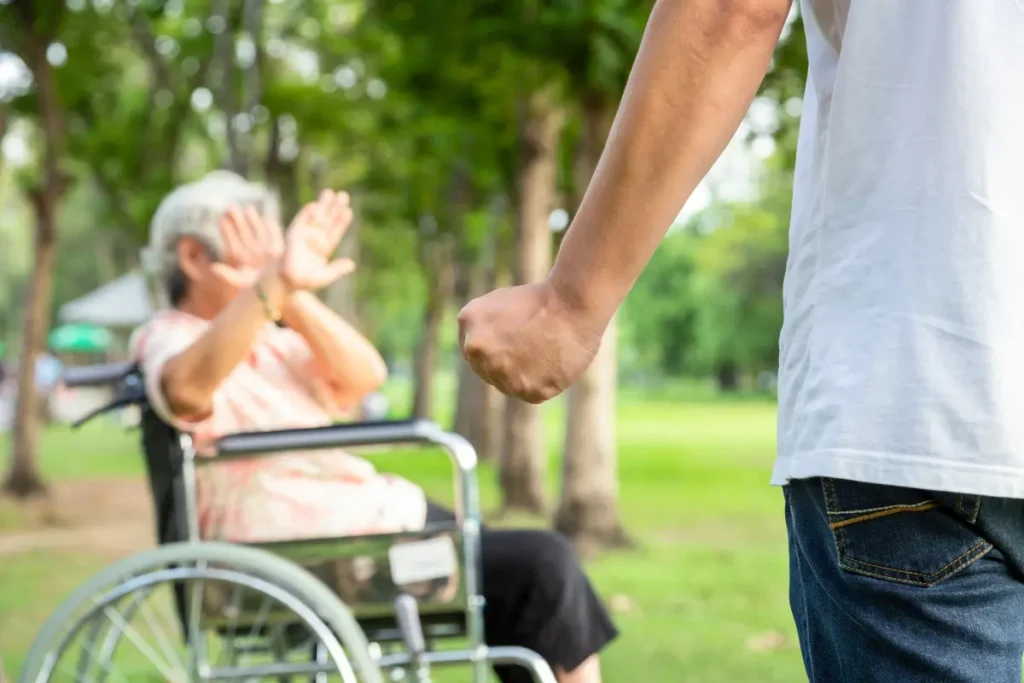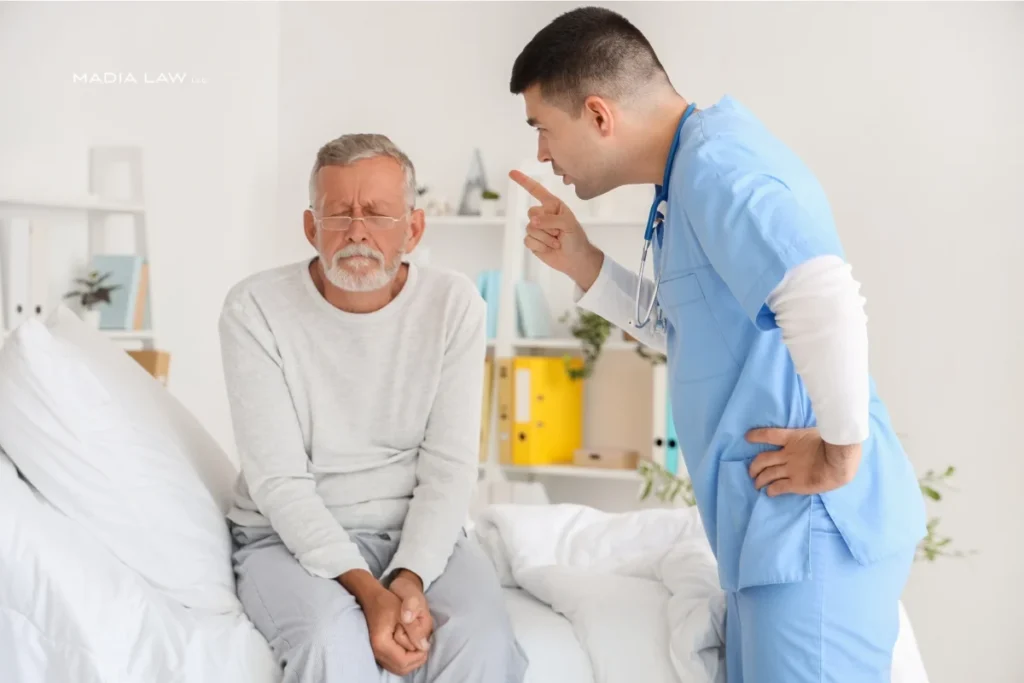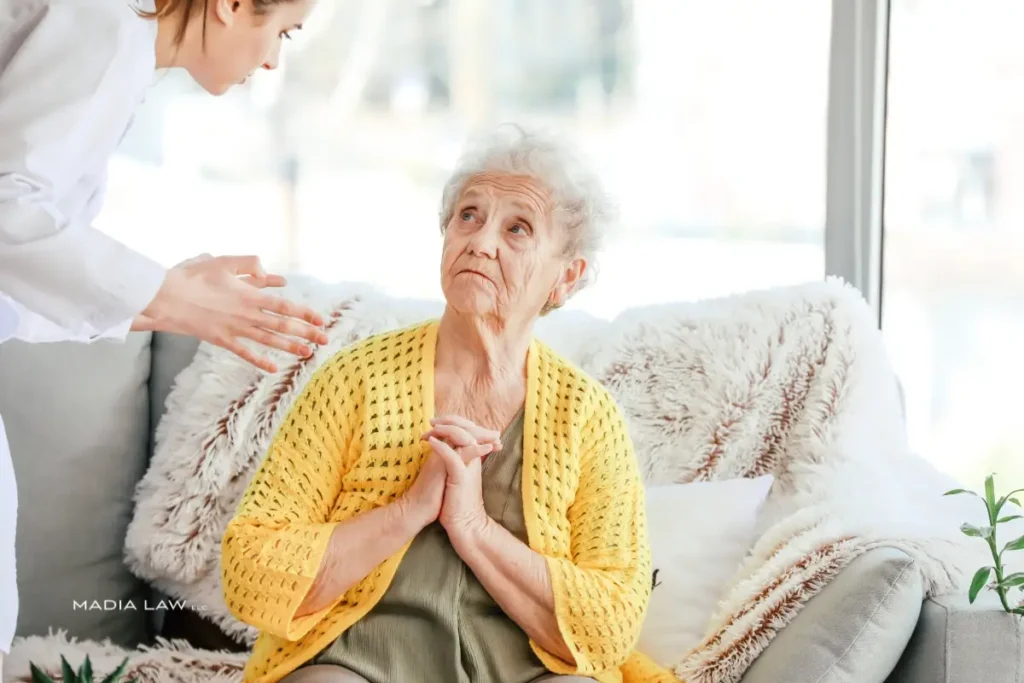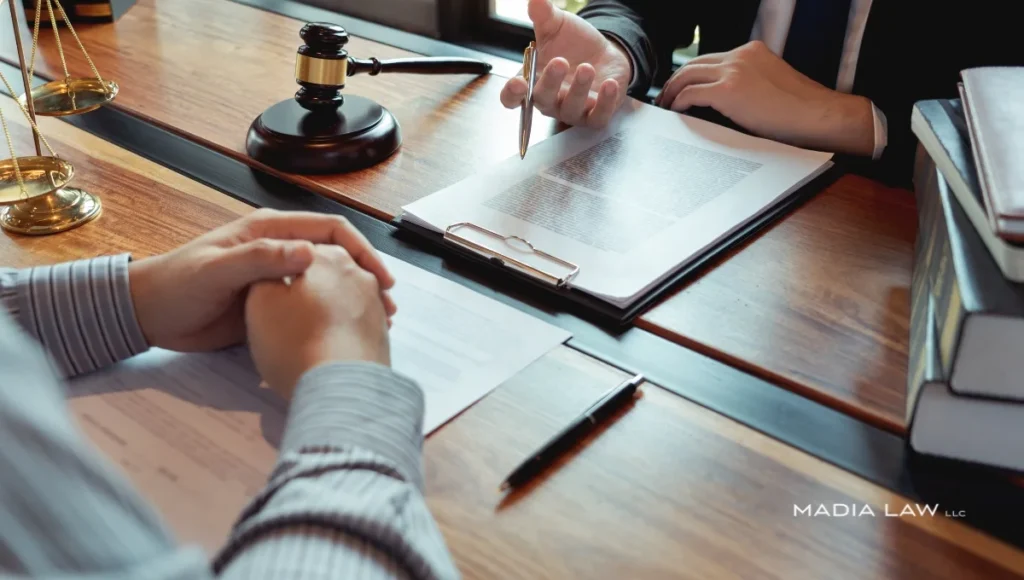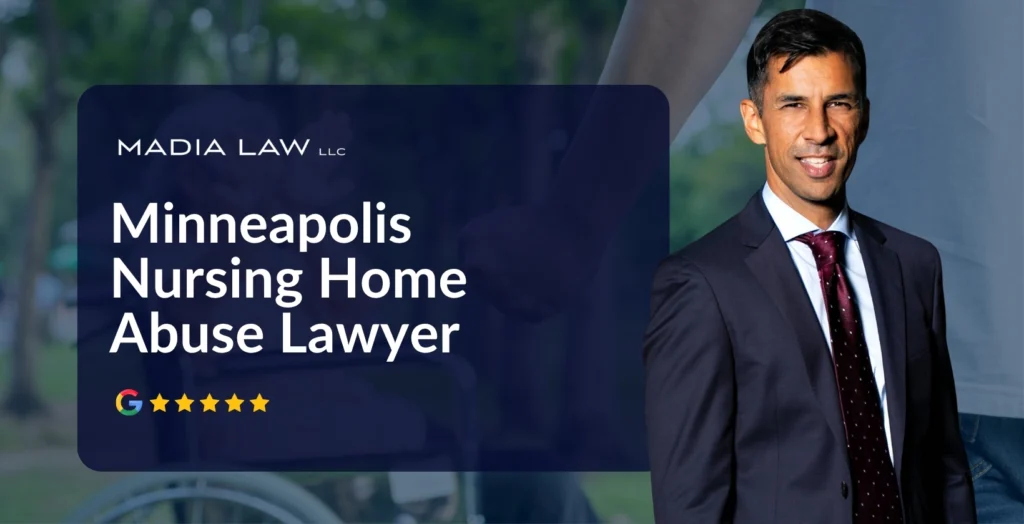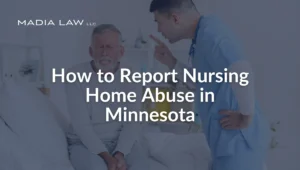
Protecting a loved one in a nursing home is a responsibility no family takes lightly. If you suspect abuse, knowing how to report nursing home abuse in Minnesota is the first and most critical step to stop the harm and seek justice. In Minnesota, concerns can be reported directly to the Minnesota Adult Abuse Reporting Center (MAARC), a 24/7 hotline operated by the Department of Human Services under the Vulnerable Adult Act, at 1-844-880-1574 or through its online portal. While families can file reports on their own, working with an experienced nursing home abuse lawyer can help ensure that the report is complete, supporting evidence is preserved, and your loved one’s rights are protected throughout the process. Speaking up not only safeguards your loved one but can also prevent others from suffering in silence.
At Madia Law, we stand with families who choose to speak out. When you are ready, we are here to guide you through the reporting process and take the next steps with confidence.
Step-by-Step Guide to Report Nursing Home Abuse in Minnesota
To report nursing home abuse in Minnesota, you need to follow a defined legal process that ensures your concern reaches the right agency and receives appropriate attention. The reporting path includes five essential steps, from identifying signs to submitting details to the correct authority. Each step helps build a stronger, legally sound case. We explain all five below so you know exactly what to do and when.
Step 1: Identify Warning Signs of Abuse
Before you report anything, you need to recognize the signs that something may be wrong. Nursing home abuse often shows up through physical changes, emotional shifts, or sudden behavioral responses.
Common signs of nursing home abuse include:
- Unexplained bruises, fractures, or bedsores.
- Sudden fear, anxiety, or withdrawal from social contact.
- Poor hygiene, dehydration, or rapid weight loss.
- Changes in medication or unusual sedation.
- Missing personal items or irregular financial activity
These indicators do not always mean abuse, but if you notice a pattern, document it. Noticing and recording these signs is the first step in the legal process of reporting elder abuse in Minnesota.
Step 2: Decide Whether to Report Internally or to State Authorities
In Minnesota, you can file a report directly with the state or speak first with the nursing home itself. Where you report depends on the severity, urgency, and who is involved.
Consider reporting internally if:
- It’s the first incident and seems like a mistake.
- You believe the administration will take it seriously.
- There’s no immediate safety concern.
Report directly to state agencies if:
- The abuse is serious or ongoing.
- You fear retaliation or cover-up.
- There’s a risk of harm to other residents.
In most cases of elder abuse, we recommend reporting to both the facility and the state to document concerns at every level.
Step 3: Submit Your Report to the Correct Minnesota Agency
Once you decide to report, send the complaint to the proper authority based on the situation. Minnesota has several official agencies that handle nursing home abuse.
Where to report nursing home abuse in Minnesota:
- Minnesota Adult Abuse Reporting Center (MAARC)
For all general elder abuse concerns in licensed facilities.
Call: 1-844-880-1574 (available 24/7). - Minnesota Department of Health (MDH)
For complaints involving licensed health professionals
File online at: health.state.mn.us - 911 or local police
For emergencies or criminal conduct, including assault or theft.
Reporting to the right agency ensures your concern triggers the appropriate investigation under Minnesota law.
Step 4: Prepare the Evidence and Details for Reporting
To file a strong report, you need to include specific details. Clear and complete information helps authorities investigate more efficiently and effectively.
What to include in an elder abuse report:
- Full name of the resident.
- Name and address of the nursing home.
- Dates, times, and locations of incidents.
- Descriptions of physical or emotional harm.
- Names of witnesses or involved staff.
- Photos, medical records, or written notes (if available).
Write clearly and stick to the facts. Good documentation gives your report more legal weight and credibility.
Step 5: Choose to Report Anonymously or as a Family Member
In Minnesota, you have the right to report nursing home abuse anonymously. This protects your identity but may limit follow-up.
Anonymous reporting means:
- Your name is not shared with the facility.
- Investigators may not be able to clarify your report.
- You won’t receive case updates.
Named reporting allows:
- Investigators to follow up with questions.
- Full protection under Minnesota’s whistleblower laws (Minn. Stat. § 626.557).
- Stronger legal documentation and transparency.
If you are unsure, know this: state law protects anyone who reports abuse in good faith. You have legal rights, and retaliation is not allowed.
For a legal consultation, call 612-349-2729
Which Authorities Handle Elder Abuse Investigations in Minnesota?
Elder abuse investigations are handled by multiple government entities in Minnesota, each with a specific role based on the nature of the complaint. The Minnesota Department of Health, Adult Protective Services, and local law enforcement all investigate nursing home abuse, but their involvement depends on what happened, where it happened, and who is at risk. Below, we explain how these agencies divide responsibilities.
Role of the Minnesota Department of Health vs. Adult Protective Services
Both the Minnesota Department of Health (MDH) and Adult Protective Services (APS) respond to abuse, but their focus is different. Understanding this distinction helps ensure your report reaches the right agency.
| Agency | Primary Focus | When They are Involved |
|---|---|---|
| Minnesota Department of Health (MDH) | Licensed healthcare facilities and medical staff | Allegations of abuse by nurses, care staff, or facility-level failures like poor hygiene or safety |
| Adult Protective Services (APS) | Protection of vulnerable adults across all living situations | Non-medical abuse or neglect, including emotional abuse, financial exploitation, or caregiver misconduct |
Example:
- If a nurse overmedicates your parent or grand parents or fails to treat wounds, MDH investigates.
- If a staff member threatens your loved one or steals their belongings, APS takes the lead.
In many cases, both agencies coordinate investigations, especially when medical and non-medical concerns overlap.
When Police or County Agencies Get Involved
Law enforcement plays a role when elder abuse crosses into criminal behavior, like assault, theft, sexual abuse, or threats of violence. County human services may also step in if there are broader welfare concerns, especially if multiple residents are at risk.
Police typically get involved when:
- There’s physical harm or evidence of criminal conduct
- The facility fails to respond to state agency investigations
- Immediate safety is at risk
County social services or human services often assist APS with investigations or provide services like emergency relocation or guardianship interventions.
If you believe a crime has occurred or someone is in danger, call 911 immediately. Otherwise, your report to MAARC or MDH may be forwarded to police if necessary.
Understanding Mandatory Reporting Laws in Minnesota
Minnesota law requires certain individuals to report suspected abuse, neglect, or financial exploitation of vulnerable adults, including nursing home residents. This system, called mandatory reporting, helps ensure serious issues are not ignored or hidden.
Who Must Report Elder Abuse by Law?
Under Minnesota Statutes § 626.557, specific professionals, called mandated reporters, are legally required to report suspected abuse or neglect of vulnerable adults. Failing to report when required can lead to legal consequences.
Mandated reporters include:
- Nurses and healthcare workers
Required to report physical abuse, neglect, or improper care they observe or suspect in the course of their job. - Social workers and case managers
Must report when they see or hear signs of abuse during client visits or service coordination. - Licensed care facility staff and administrators
Obligated to report concerns involving other staff, facility conditions, or patient care. - Emergency responders (EMTs, paramedics, fire personnel)
Must report if they encounter signs of abuse while responding to calls. - Law enforcement officers
Required to report suspected abuse during the course of any police interaction or investigation.
If you fall into one of these categories and suspect abuse, the law requires you to report it immediately, not just when you are certain abuse has occurred.
Legal Protections for Whistleblowers
Minnesota law protects anyone, whether mandated or voluntary, who reports suspected elder abuse in good faith. Under Minn. Stat. § 626.557, Subd. 17, whistleblowers are shielded from retaliation by employers, coworkers, or institutions.
This means:
- You cannot be fired, demoted, or disciplined for filing a report
- Your identity is kept confidential during the investigation whenever possible.
- If retaliation does occur, you may have grounds for a separate legal claim.
If you are concerned about job risk, legal exposure, or privacy, know that the law is designed to protect you, not punish you, for doing the right thing.
Click to contact our personal injury lawyers today
How to Collect and Preserve Evidence for a Legal Claim
If you suspect nursing home abuse, gathering evidence early can make a major difference in the strength of any future legal claim. Strong documentation helps prove what happened, when it happened, and who was involved.
What Types of Evidence Are Legally Admissible?
Courts only accept evidence that is reliable, relevant, and legally obtained. The stronger and more organized your materials are, the more likely they will support a successful claim.
Common types of admissible nursing home abuse evidence include:
- Medical records
Includes hospital visits, diagnoses, injury documentation, and medication logs showing neglect or harm. - Staff reports and internal facility logs
Documents daily care routines, staff shifts, incident reports, and any patterns of poor care or complaints. - Photos and video recordings
Shows physical injuries, unsafe living conditions, or neglected hygiene; date-stamped images hold more weight. - Eyewitness statements
Written or recorded accounts from other residents, family members, or staff who observed abusive behavior. - Financial documents
Banking records, billing statements, or missing assets in cases of financial exploitation.
To increase admissibility, make sure your evidence is factual, unaltered, and collected without violating privacy laws. If in doubt, consult an attorney before recording or photographing inside a facility.
How to Store and Present Documentation Properly
Preserving evidence isn’t just about saving files, it’s about keeping records secure, organized, and legally valid. Poor storage or lost files can weaken your case or make evidence inadmissible.
Best practices for handling elder abuse evidence:
- Label everything clearly with names, dates, and a short description.
- Save digital files in multiple formats (PDF, JPG, MP4) and back them up on secure, password-protected drives.
- Keep physical items like printed records or handwritten notes in a folder or envelope with the date collected.
- Preserve metadata in photos or videos by not altering or editing the original files.
- Document the chain of custody, especially if evidence is passed between family members or lawyers.
Well-preserved evidence shows consistency, credibility, and intent to act. If you are preparing for legal action, this step can be just as important as filing the claim itself.
Complete a Case Evaluation form now
Why Timely Reporting Can Prevent Future Harm
Reporting nursing home abuse isn’t only about protecting your loved one, it’s about preventing harm to others who may not have anyone to speak up for them. When abuse goes unreported, the problem doesn’t stop; it spreads. Timely reporting can trigger investigations, alert oversight agencies, and help stop neglect or mistreatment before it becomes widespread. The following sections explain why early action matters and how a single report can lead to broader protection.
How Delayed Action Can Let Abuse Continue
Waiting too long to report nursing home abuse often allows dangerous patterns to continue unnoticed. Facilities may ignore complaints internally, especially if no outside authority gets involved. This can lead to repeated harm, not just to one resident, but to others who face the same staff, policies, or neglectful practices.
Example:
If a family notices unexplained bruises but waits several months to act, the facility may continue underreporting or hiding incidents. During that time, the same caregiver could harm other residences, and records that could support an investigation may be lost or changed. Delays give institutions time to cover tracks, and allow abuse to repeat itself.Your Report Might Trigger Broader Investigations
One report can lead to much more than a single investigation. When you notify MAARC, MDH, or law enforcement, the complaint may uncover systemic issues, trigger state inspections, or result in licensing reviews for the entire facility.
Example:
A single report about missed medications might lead to an unannounced health inspection. That inspection could reveal staffing shortages, falsified records, or other residents in similar situations. In some cases, one family’s complaint leads to statewide policy changes, fines, or even facility shutdowns.
Your action doesn’t just protect your loved one, it may protect dozens of others. Reporting creates accountability, and accountability stops abuse.
What Constitutes Nursing Home Abuse in Minnesota
Not every negative experience in a nursing home qualifies as legal abuse under Minnesota law. Frustration, miscommunication, or isolated incidents, while upsetting, may not meet the legal definition of abuse or neglect. This section explains how Minnesota distinguishes between true elder abuse and situations that, while concerning, do not rise to a legally actionable level. Understanding the difference can help families know when to report and what kind of response to expect.
Types of Abuse Recognized Under State Law
Under Minnesota Statutes § 626.5572, abuse of a vulnerable adult includes several clearly defined categories. Each has legal weight and can justify intervention, investigation, or civil action when properly documented.
Recognized types of nursing home abuse include:
- Physical abuse
The use of force that results in pain, injury, or distress. This includes hitting, slapping, pushing, or the improper use of restraints. - Emotional or psychological abuse
Verbal attacks, threats, humiliation, or isolation that causes fear, anxiety, or withdrawal. - Sexual abuse
Any non-consensual sexual contact, including unwanted touching or exposure. This also includes activity with a resident who cannot legally consent due to cognitive decline. - Financial exploitation
Unauthorized use of a resident’s funds, credit cards, or assets. This includes pressured changes to wills, theft, or misuse of Power of Attorney. - Neglect
Failure to provide adequate food, medical care, hygiene, or supervision, especially when that failure leads to harm or puts the resident at risk.
These forms of abuse are legally actionable and should be reported to state agencies or law enforcement as soon as they are discovered.
Incidents Not Considered Legal Abuse
Some events may feel wrong or emotionally upsetting but do not meet the legal threshold for abuse in Minnesota. Knowing this helps families manage expectations and avoid unnecessary legal steps.
Examples of non-abuse situations include:
- Unexpected medical complications from a known condition, even if outcomes are poor.
- Accidental falls that occur despite reasonable supervision and safety measures.
- Refusal of care by a resident with full mental capacity.
- Delays in service caused by staff shortages when not tied to intent or recklessness.
- Miscommunication or personality conflicts that do not involve mistreatment.
While these situations may still justify complaints, discussions with facility leadership, or internal reviews, they do not always result in legal or regulatory action.
Legal Options After Reporting Nursing Home Abuse
Filing a report is an important first step, but for many families, it’s just the beginning. If the abuse resulted in serious harm or the facility failed to act, you may have legal grounds to pursue compensation.
When Does Nursing Home Abuse Warrant a Lawsuit?
A civil lawsuit becomes possible when the abuse or neglect leads to measurable harm, such as injury, financial loss, emotional trauma, or death, and the facility or staff can be held legally responsible.
Under Minnesota Statutes § 144.651 and § 626.557, a nursing home may be liable if:
- Staff caused injury through negligence or misconduct.
- The facility failed to supervise, medicate, or feed a resident properly.
- Abuse was reported internally, but no corrective action was taken.
- A resident’s rights were knowingly violated under the Minnesota Patients’ Bill of Rights.
Example: If a resident suffers severe bedsores due to staff neglect or dies from untreated injuries, families may have grounds to sue for damages. A qualified nursing home abuse attorney can help determine whether the facts meet the legal threshold.
What Legal Remedies Are Available to Families?
Victims of nursing home abuse, and their families, may be entitled to several forms of compensation depending on the outcome of the case.
Possible legal remedies include:
- Medical expenses
Reimbursement for hospital stays, treatment, rehabilitation, or long-term care caused by the abuse. - Pain and suffering
Compensation for physical pain, emotional distress, and diminished quality of life. - Wrongful death damages
If a loved one dies due to abuse or neglect, families may seek funeral costs and loss of companionship. - Punitive damages
In rare cases involving reckless or intentional harm, courts may award extra compensation to punish wrongdoing. - Injunctive relief
Legal action requiring the facility to change its practices or improve safety standards.
These remedies aim to restore what was lost and prevent future harm to others in similar situations.
Minnesota’s Statute of Limitations for Nursing Home Abuse Claims
Every legal claim has a deadline, and nursing home abuse cases are no exception. In Minnesota, the statute of limitations for most elder abuse lawsuits is 2 to 4 years, depending on the nature of the claim.
General timelines:
- Personal injury or negligence: 2 years from the date of injury or discovery.
- Wrongful death: 3 years from the date of death (must be within 6 years of the act).
- Medical malpractice involving licensed providers: 4 years from the date of harm.
There are exceptions if the victim is mentally incapacitated or if fraud prevented timely discovery. Waiting too long may mean your case can’t be filed, no matter how strong the evidence.
How Madia Law LLC Helps Victims and Families Seek Justice
At Madia Law LLC, we do not back down from powerful institutions. We are Minnesota trial lawyers who prepare every case like it’s going to court, and that’s what makes us different. We investigate claims thoroughly, gather expert testimony, and take the time to understand the real impact abuse has had on your family.
Whether you are unsure about your legal options or ready to file a claim, we’re here to walk you through every step. We know how hard it is to trust the legal system after it failed someone you love. Our job is to make sure that failure is answered with truth, accountability, and justice.
When to Speak With a Minnesota Nursing Home Abuse Attorney
After reporting abuse, certain situations call for more than just a state investigation, you may need legal representation. If the facility denies wrongdoing, your loved one suffers serious injury, or no action is taken after your report, speaking with an attorney becomes critical.
Common signs it’s time to contact a nursing home abuse attorney:
- The facility blames the resident or minimizes your concerns.
- There’s evidence of repeated harm, neglect, or cover-ups.
- You are struggling to get records, updates, or clear answers.
- The abuse resulted in hospitalization, long-term trauma, or death.
- State agencies confirm violations, but no real change happens.
A Minnesota nursing home abuse lawyer can evaluate your case, preserve key evidence, and make sure the facility is held accountable not just internally, but legally. At that point, you are no longer just reporting abuse, you are pursuing justice.
What to Expect After You File a Nursing Home Abuse Report
After you file a report in Minnesota, whether through MAARC, MDH, or law enforcement, the case is reviewed to determine if it warrants a formal investigation. If accepted, an investigator may contact you for more information or visit the facility to examine records, interview staff, and speak with the resident.
Typical follow-up timeline:
- Initial screening: within a few days.
- Assignment to investigator: 5-10 business days.
- Investigation completion: often within 30-60 days, depending on complexity.
- Outcome: may result in findings of substantiated abuse, citations, or no violations.
You may not receive all details due to privacy laws, but if action is taken, the facility may face fines, license restrictions, or mandatory corrective plans. Even if no violation is found, your report is logged and may support future investigations if issues persist.
Contact Madia Law LLC to Hold Negligent Facilities Accountable
If you are here, you have already done the hardest part: recognizing something’s wrong. Now let’s take the next step together. At Madia Law LLC, we help Minnesota families stand up to nursing homes that put profits before people. We are trial-ready, experienced, and committed to holding abusive facilities legally accountable.
Contact us today at 612-349-2729 for a confidential, no-obligation conversation about your legal options.
Call 612-349-2729 or complete a Case Evaluation form

